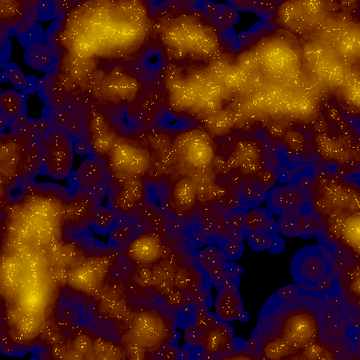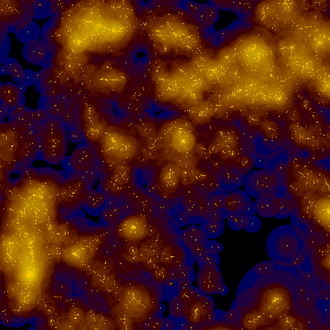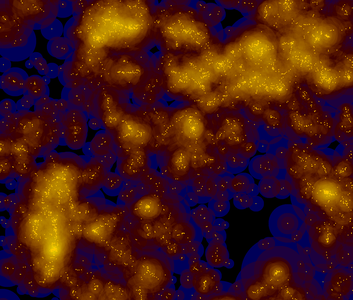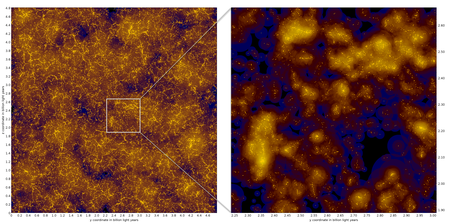Light in the dark - Galaxies enriching MultiDark universe
Scientists from the Leibniz Institute for Astrophysics Potsdam (AIP) have joined an international research team to create one of the largest sets of galaxies in a computer generated universe. The data are published via AIP's CosmoSim database.
The Universe is filled with an immeasurable number of galaxies that themselves are accumulations of billions of stars. Understanding how these 'islands in the universe’ formed and evolved and how they are distributed throughout the Universe is central to the field of Cosmology. Luckily, we now live in an era where both ground- and space-based telescopes are being designed to study the Universe out to unprecedented distances, peering back billions of years to when the Universe was an infant. But the interpretation of these data requires theoretical models. As such, astronomers generate model universes, where galaxies are simulated, which may act as a test bed for the assessment of theories. However, such virtual universes are computationally expensive, numerically challenging, and often lack the sheer number and details of the galaxies we observe.
Now, an international team led by Prof. Alexander Knebe from the Universidad Autónoma de Madrid and Prof. Francisco Prada from the Instituto de Astrofísica de Andalucía (bringing together experts from South America, the USA, Europe, and Australia) has created one of the largest publicly available virtual universes, known as the “MultiDark-Galaxies”. What is provided to the community are galaxy catalogues based upon three distinct models that all include the physical processes relevant for galaxy formation and evolution, conforming to and reproducing specific empirical observations.
All galaxy data and also data for the simulation itself is available via the database www.cosmosim.org, hosted at the Leibniz-Institut for Astrophysics Potsdam in Germany. A selected subset is also available at www.skiesanduniverses.org, hosted at NMSU in the US and the Instituto de Astrofísica de Ansalucía CSIC in Spain. The more than 100 million virtual galaxies per model cover a cosmological volume comparable to that probed by on-going and future observational campaigns. They therefore equip researchers in the field with an unparalleled opportunity to better understand existing observations and to even make predictions for upcoming missions. More information can be found in the accompanying paper that has just been accepted by MNRAS and can be found on the arXiv: 1710.08150
Further information
Original press release by Universidad Autónoma Madrid: https://www.uam.es/
More information about MultiDark: http://www.multidark.es
More information about CosmoSim database: https://www.cosmosim.org/
Database contacts:
Kristin Riebe, +49 331-7499 377, kriebe@aip.de
Anastasia Galkin +49 331-7499 685, agalkin@aip.de
Harry Enke, +49 331-7499 433, henke@aip.de
The CosmoSim database is a service by the Leibniz-Institute for Astrophysics Potsdam (AIP). It contains public data from cosmological simulations of different sizes and resolutions. The data can be accessed via a web interface and Virtual Observatory tools.
Scientists from the Leibniz Institute for Astrophysics Potsdam (AIP) have joined an international research team to create one of the largest sets of galaxies in a computer generated universe. The data are published via AIP's CosmoSim database.
The Universe is filled with an immeasurable number of galaxies that themselves are accumulations of billions of stars. Understanding how these 'islands in the universe’ formed and evolved and how they are distributed throughout the Universe is central to the field of Cosmology. Luckily, we now live in an era where both ground- and space-based telescopes are being designed to study the Universe out to unprecedented distances, peering back billions of years to when the Universe was an infant. But the interpretation of these data requires theoretical models. As such, astronomers generate model universes, where galaxies are simulated, which may act as a test bed for the assessment of theories. However, such virtual universes are computationally expensive, numerically challenging, and often lack the sheer number and details of the galaxies we observe.
Now, an international team led by Prof. Alexander Knebe from the Universidad Autónoma de Madrid and Prof. Francisco Prada from the Instituto de Astrofísica de Andalucía (bringing together experts from South America, the USA, Europe, and Australia) has created one of the largest publicly available virtual universes, known as the “MultiDark-Galaxies”. What is provided to the community are galaxy catalogues based upon three distinct models that all include the physical processes relevant for galaxy formation and evolution, conforming to and reproducing specific empirical observations.
All galaxy data and also data for the simulation itself is available via the database www.cosmosim.org, hosted at the Leibniz-Institut for Astrophysics Potsdam in Germany. A selected subset is also available at www.skiesanduniverses.org, hosted at NMSU in the US and the Instituto de Astrofísica de Ansalucía CSIC in Spain. The more than 100 million virtual galaxies per model cover a cosmological volume comparable to that probed by on-going and future observational campaigns. They therefore equip researchers in the field with an unparalleled opportunity to better understand existing observations and to even make predictions for upcoming missions. More information can be found in the accompanying paper that has just been accepted by MNRAS and can be found on the arXiv: 1710.08150
Further information
Original press release by Universidad Autónoma Madrid: https://www.uam.es/
More information about MultiDark: http://www.multidark.es
More information about CosmoSim database: https://www.cosmosim.org/
Database contacts:
Kristin Riebe, +49 331-7499 377, kriebe@aip.de
Anastasia Galkin +49 331-7499 685, agalkin@aip.de
Harry Enke, +49 331-7499 433, henke@aip.de
The CosmoSim database is a service by the Leibniz-Institute for Astrophysics Potsdam (AIP). It contains public data from cosmological simulations of different sizes and resolutions. The data can be accessed via a web interface and Virtual Observatory tools.
Images
Visualization of the model galaxies.
Big screen size [1000 x 849, 840 KB]
Original size [1648 x 1400, 700 KB]
Visualization of the model galaxies. The left panel shows a slice of thickness 4.7 million light years through the whole simulation that itself has a side length of 4.8 billion light years. Each galaxy is represented by a yellow dot; the background indicates the underlying dark matter density. The right panel zooms into a smaller region. Here the dark matter haloes hosting the galaxies are visible as circles, colour-coded according to the projected density. Their sizes are scaled with their masses.
Big screen size [1000 x 498, 860 KB]
Original size [3611 x 1800, 2.4 MB]






